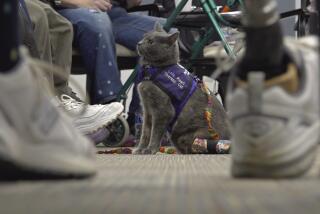Inky, Snowy Are Top Dog Therapists : Inky and Snowy are tricky, but helpful.
- Share via
The pint-sized poodle and terrier can jump through hoops, play dead, fetch on command and help rehabilitate disabled senior citizens.
Part of a new breed of canine physical therapists, the two dogs were trained from birth to perform for elderly patients in order to inspire them to work harder and more enthusiastically in their recovery programs.
Inky and Snowy recently won recognition as the best pet therapists in the Western States--an honor that earned them a trip to St. Louis.
Jeanie Wood, the occupational therapy director of the Capistrano Beach Nursing Center, has trained the dogs.
The dogs, both 5 years old, aren’t the key to any amazing turnarounds in a patient’s condition.
“They bring spontaneous happiness,” Wood said. “Everybody here loves them.”
An emerging form of treatment used at nursery homes, rehabilitation centers and mental hospitals, pet therapy fights the depression of many patients. The national Pet Partners program that honored Inky and Snowy is sponsored by a national group that is promoting animal-assisted treatment throughout the country.
But Inky and Snowy take pet therapy one step further. Their use goes beyond lifting spirits. The dogs also were trained by Wood to help treat people suffering physical problems.
Wood taught the dogs tricks. Simple stunts like playing dead and rolling over make Inky and Snowy nearly irresistible to patients, some of whom find it hard to communicate with people, Wood said.
Patients take the role of ringmaster, guiding the dogs through their tricks. Simple acts such as raising their arms to get the dogs to stand up in unison are also badly needed exercise.
A large part of pet therapy is still bringing a positive “home-like environment in a patient’s surroundings,” Wood said.
Having Inky and Snowy around brings back “good memories of past happy times,” Wood said. “Animals provide that unconditional love, and that improves (patients’) quality of life. That’s very valuable.”
More to Read
Sign up for Essential California
The most important California stories and recommendations in your inbox every morning.
You may occasionally receive promotional content from the Los Angeles Times.













